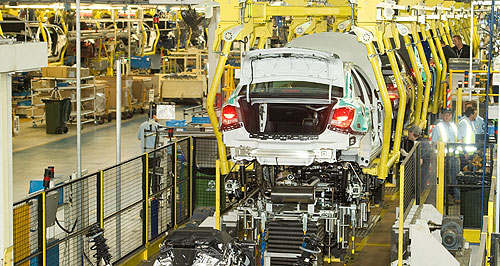News - HoldenHolden reveals local spend in pitch for survivalCruise missile: The latest news reports out of Detroit suggest GM has committed to a shift of Australian car-making capacity to Korea from 2016. Locally made cars soak up $15,400 in Aussie parts, PC submission shows3 Dec 2013 By BARRY PARK HOLDEN has revealed it spent an average of $15,400 on local parts for each car that rolled off its Adelaide production line last year. A breakdown of its Australian car-making business submitted to the Productivity Commission inquiry into automotive manufacturing shows Holden spent almost $600 million buying parts for the Commodore passenger car and ute range, and Cruze small car. The steel alone, sourced from Australian supplier BlueScope Steel, cost an average of about $470 a car. The submission reiterates much of what Holden has said about its struggle to keep its Australian business viable in the light of rising costs compared with other General Motors-owned car-making businesses internationally. However, it goes into surprising detail to spell out a cost-cutting deal struck with unions last month that Holden says will help it to reduce the $3750 in extra expenses it struggles with above the GM-wide average cost of manufacturing. According to the car-maker, the new productivity concessions granted by unions on behalf of the company’s 1100 blue-collar workers include an extra 16 minutes of work a day, greater flexibility with casual workers, wage freezes, and a minimum hourly rate that is almost $2 an hour less for new workers joining Holden’s factory floor. As well, 25 pre-existing allowances have been cut to just 13. On the question of industry assistance, Holden said it had to seek financial support from its parent company as well as the Australian government. “Holden, as a subsidiary of GM, must compete with its global GM counterparts for internal capital investment, as well as demonstrate appropriate levels of return for that investment,” the submission says. “Automotive manufacturing assistance is needed in two forms investment attraction and investment return, which relates to sustainability. “Investment attraction is periodic in nature and aligns itself with new model development timelines. An effective level of capital investment assistance which has worked is a 1:3 ratio of public assistance, to investment by the car-maker. “In recent years, on average, GM has invested $3 for each dollar of capital investment assistance provided by the Australian government. “The (now defunct) Green Car Innovation Fund was an example of this type of assistance, and was successful in attracting foreign investment.” Holden’s submission says the $2.5 billion Automotive Transformation Scheme, which the federal government plans to reduce by $500 million, was essential to sustain the industry. “To be globally competitive with other countries which are providing perpetual assistance to their local automotive manufacturing industries, Australian automotive assistance needs to be set at appropriate levels and be ongoing,” Holden says. Holden presents its argument to the Productivity Commission in a special hearing on December 10. The car-maker is set to make a decision on its commitment to building a new generation of the Cruze hatchback, due at the end of 2016, early next year. It also plans to build a replacement for the current Commodore, based on a new global platform, later this decade, providing it receives enough government support.  Read more |
Click to shareHolden articlesResearch Holden Motor industry news |

















Facebook Twitter Instagram